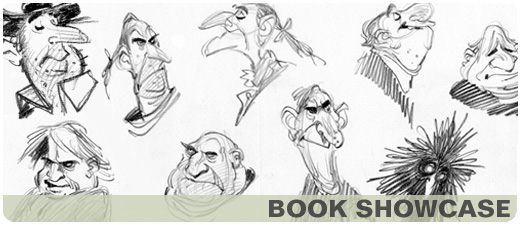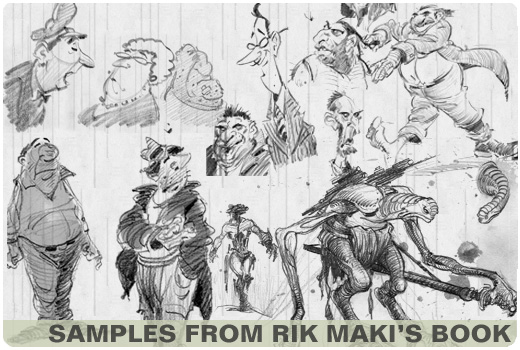Hello there!
Welcome back to our monthly Tips & Tricks article, where I pretend to know all kinds of mysterious secrets of animation. Hopefully they've made at least a little bit of sense so far! Last month I veered off onto a tangent about how we are all actors, and how we must think of ourselves that way, but I also promised to be more practical this month, so what to talk about?
Well, this morning I got an interesting question from someone about exaggeration - specifically, how much exaggeration is too much? Where do you draw the line?
Sounds pretty practical to me, so that's what we'll be talking about today! (See how lazy I am? Good thing he didn't ask me about my favorite socks, or else you'd all be hearing about the magic of Thorlo socks for 2 pages!)
Okay, so...
If you're an Animation Mentor student, you've seen the video lecture about exaggeration, and know how important it is. You know John Lasseter describes exaggeration as "accentuating the essence of an idea via the design and the action." You know the amount of exaggeration is probably the single biggest defining aspect of the style of the animation. You know how to use it to sell the weight of a character, or to spotlight a story point. Above all, you know that exaggeration is used for clarity. Clarity of ideas, clarity of jokes, clarity of personality, and clarity of physical traits.
But that overriding question comes up again and again, especially in our first few years of animating -- how much is too much?
So, here's my two cents on that:
Tip #5: It's Too Much Exaggeration When the Audience is Confused
Yeah, I know that sounds like a "duh" statement, but I really think that's the answer. Once again, it boils down to the fact that animation is both a collaborative and a communicative medium. You aren't just animating something for yourself and your Mom, you're trying to create a piece of art that speaks to people. That will make them laugh, or tell a story, or further a plot point, or show off a cool character trait.
The only way to know if your animation is working, once again, is to show it to someone. To make the conscious effort to seek out quality feedback on your work. Again, your best bet is usually to show it to a fellow animator, but almost anyone can give you feedback on your work. Your father might not be able to tell you how to fix something, but he'll probably be able to at least tell you whether or not he can read the emotion of the character, or understand what's going on. Even that can be a huge help to you.
Anyway, if the whole point of exaggeration is clarity (which would be a whole series of articles alone, so I'm not even going down that road right now!) then the only way to know if you've used exaggeration successfully is to show it to someone. You can go really far with your animation without showing it to anyone, but at a certain point, you *must* get the opinion of someone who hasn't seen it before, and doesn't know ahead of time what is intended to be happening in the scene. If they get it, then congratulations, you've nailed it! If they don't, then it's time to take a hard look at your scene and figure out why they've missed the story point, or the gag, or whatever it is you were trying to sell in your shot.
Exaggeration is a very delicate thing to play with. You must balance reality with your exaggeration -- you have to ground it in a foundation of our universe. If you just start randomly exaggerating everything in sight, the scene will be convoluted, confusing, and impossible to watch. You have to give the audience a foothold in reality, or they will have no way to connect to your work.
This applies to every level of exaggeration, in my opinion. Exaggeration in cartoonier work (such as Warner Brothers), realistic work (such as Weta), and everywhere in between.
A lot of people mistakenly think that exaggeration has no place in realistic animation, by the way, and they couldn't be further from the truth. Even in studios such as ILM, Weta, and Sony, where we are trying to painstakingly create something as believable as the actual human actors our characters/creatures/monsters/aliens are standing next to -- we still employ the idea of exaggeration every day. We simply use it on a much subtler level than it would be used for say, Ice Age 2 or Madagascar.
As Ollie Johnston said, "Don't make it real, make it believable."
That applies just as much to the "realistic" work of the FX studios as it did to Disney's. Again, it's all in how much you use.
A tiny bit of exaggeration can take realistic work and push it into something dynamic, entertaining, and exciting, but still believable. Anyone who's worked with mocap knows the amazing difference a bit of carefully applied animation principles can make - bringing it from a truly realistic (but often dull and lifeless) performance, and turning that into something worth watching.
The more exaggeration you apply, the cartoonier your work gets. Madagascar is cartoonier than Ice Age is cartoonier than Incredibles is cartoonier than Kong. The only reason for this is the varying levels of exaggeration used in the movement, and that level of exaggeration is defined by the chosen style of each of those films.
So, as far as "how much is too much?" the first question you need to ask yourself is: "What is the style of this project?" Is it super stylized? Exaggerate your heart out! Realistic? Better reign that exaggeration in, or your supervisor is going to be wondering what you're smoking!
So, how much is too much? Well, it's too much if you exaggerate beyond the bounds of the style you are working in, for one thing. I can't exaggerate a dragon in Eragon nearly as much as someone could exaggerate a dragon in Shrek, for example. But I'm still exaggerating. I'm exaggerating poses and timing to try to have something look as dynamic as possible. I push those silhouettes, accentuate the lines of action, etc. I just can't be as broad on this film, as I could have if I had worked on something like Ice Age, that's all.
Neither is better, of course, it's just applying the same exact principles in different amounts.
If you are new to animation, the first thing I'd suggest is watching a LOT of animation and trying to absorb the differences between the various styles you see. The second (and more important) thing I'd suggest is to get in there and start experimenting. If you animate a bouncing ball, do a few different variations of exaggeration levels. Maybe do one that looks real, one that looks super cartoony, and one that's somewhere in between.
But again, how do you know when you've crossed that line? You show it to someone!!!
If you are scared to show your work to someone, well, I'm really sorry, but get over it. The truth is that if you are going to be a successful animator, a part of your job will be having a thick skin. You have to train yourself to like criticism. To seek it out, in fact! There aren't very many jobs where people have to actively seek out criticism, but without it, your animation will never be very strong. It's how we learn, and it's how we grow.
In a studio, you'll sit in dailies, surrounded by your peers, many of whom will be more experienced than you. You'll have to see your work, as rough as it may be, shown up there on the big screen to a room full of people who's job it is to judge you. You'll have to be open to their comments. You'll have to listen to them talk about your mistakes.
The first few times you're in dailies, this is the scariest thing in the world, but eventually your skin hardens into a criticism-repelling shell, and you can see the comments for what they truly are - people trying to make the project as good as it can be.
Okay, I can feel myself being pulled down yet another tangential causeway into a whole new topic of being open to feedback, so I'm going to flip this boat around and get back to exaggeration before it's too late, and we're lost for all time...
Exaggeration. How much is too much? It's too much if you break the rules of the universe your work takes place in (different rules for different projects, of course. The universe of the Matrix is slightly different than the universe of Star Wars, just as the universe of the Incredibles is slightly different than the universe of Toy Story, for example. And secondly, it's too much if you push things to the point where the audience does no longer clearly understand your work.
And for both, the only way to know, is to (I know, how many times can I say this in one article?!) show it to someone. (That’s the last time, I swear).
The whole point of exaggeration is to make things more clear, but it's easy to zip right by the world of clarity and into the Land Of Confusion, so be really careful, and get some other eyes on your work before you spend too much on it. (Oops, okay, THAT was the last time. Really.)
And like anything else, planning exaggeration is essential. You don't just guess. You don't just start scaling curves to create bigger movements all over the place. Exaggeration should be as carefully planned as any other aspect of your scene. If everything is exaggerated, your scene will be a mess. If only one thing is exaggerated, it's going to stick out like a sore thumb and feel very unrealistic in all but the cartooniest work.
Okay, that's it. See ya next time!
Have fun, and keep animating!!





